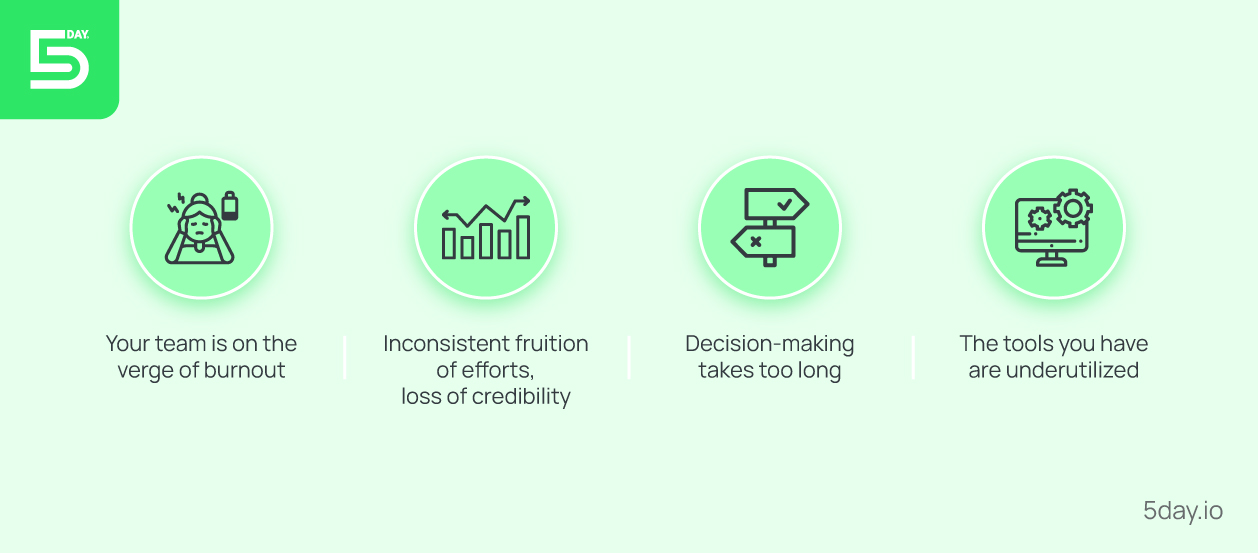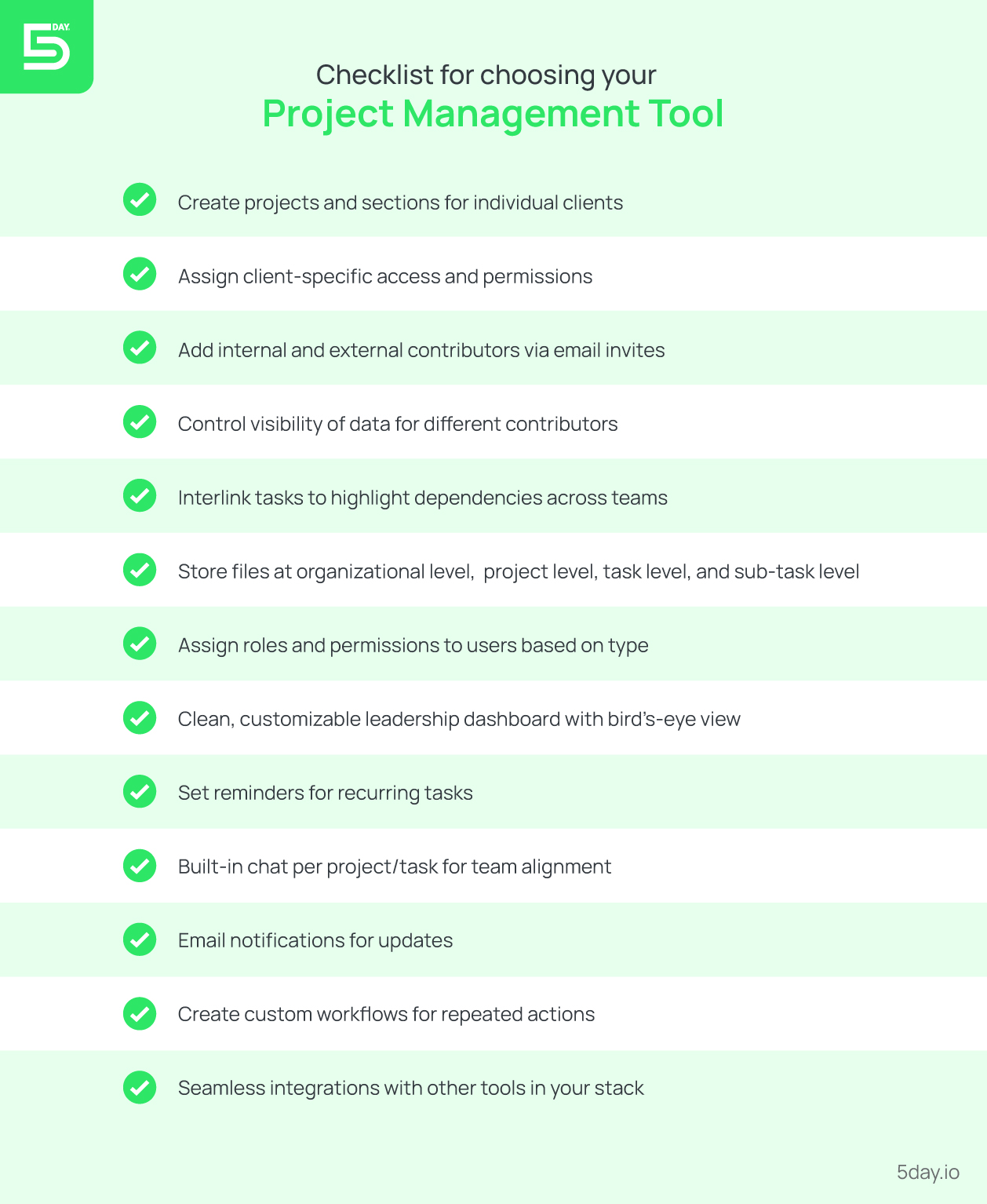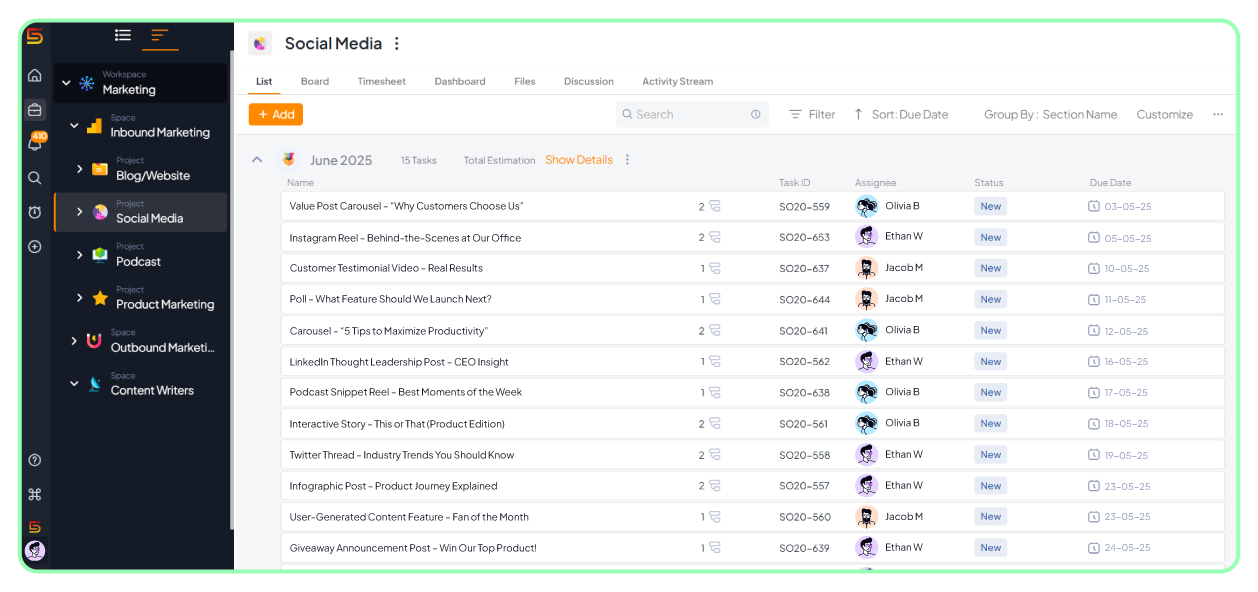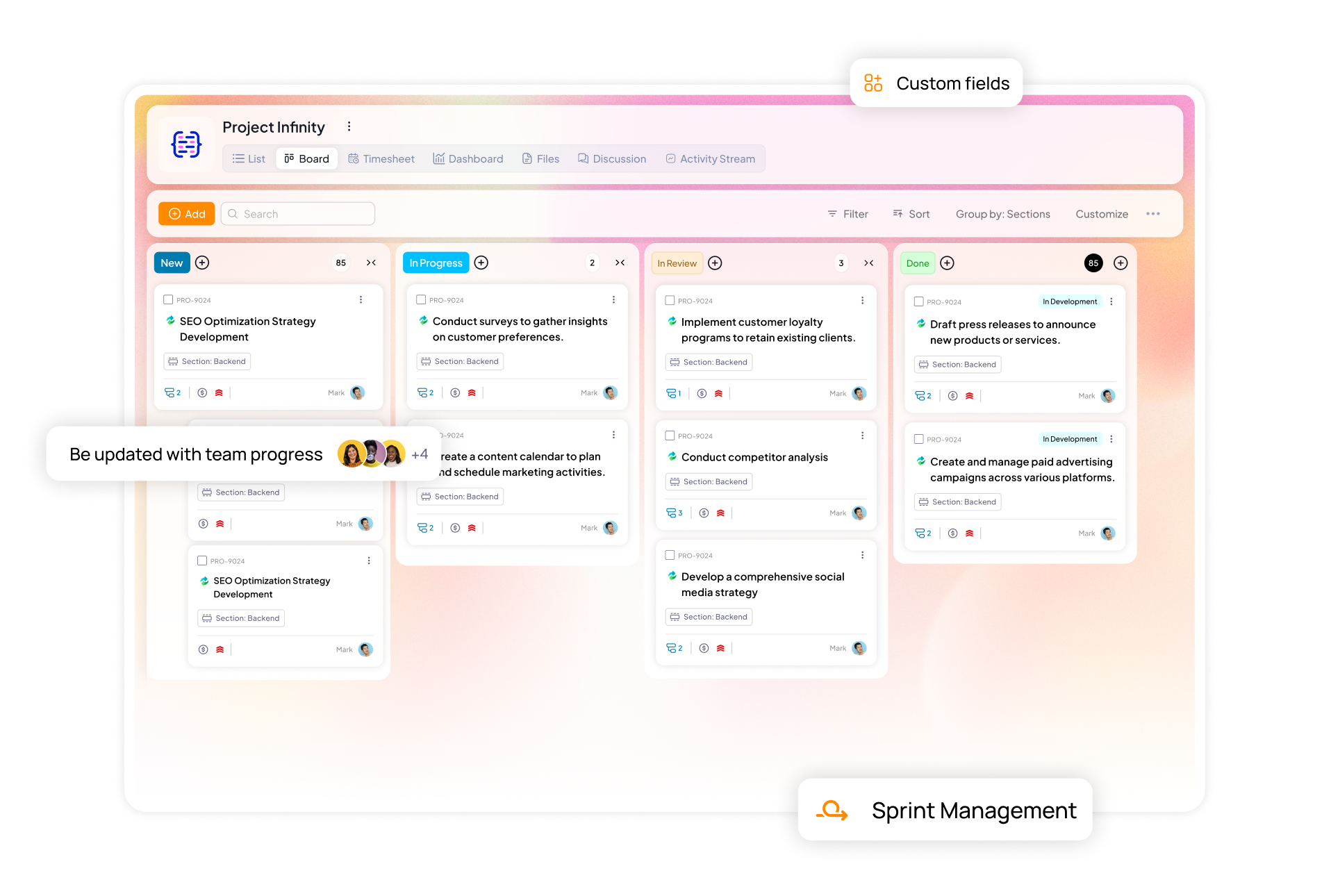You’ve poured your heart and soul into a marketing campaign, every detail meticulously planned, and every creative decision made with care. Your team is energized, eyes bright with the promise of something big.
But then everything starts to crumble. The content isn’t ready in time, approvals drag on endlessly, and important decisions are left hanging.
The energy fades. The momentum stalls. What was supposed to be a celebration of your creativity and strategy turns into a frantic scramble, and the campaign loses its spark. This is the human cost of poor project management. It’s the deep frustration of watching your dreams slip through your fingers.
We’ll talk about these in detail in this article and guide you through what you can do to keep them from pulling you down.
Disorganization in marketing project management – Your overwhelm is bringing you down

Marketing is a complex function. Everyone juggles a bunch of things, and everyone else in the organization somehow tends to have an opinion on what the marketing team should improve. There are a bunch of collaterals to be revised or reviewed at any given point in time. If you’re an organization that employs both in-house and outsourced talent (like 33% of B2B marketing teams) for your function, the amount of work to be done just keeps increasing.
Tasks keep piling up, and at a point, it becomes almost impossible to see who’s doing what, how many projects each operator has, if they are working, what are their timelines, etc. So you do what every manager does when things are overwhelmingly out of control. You call for a status update meeting, whip out a new Excel sheet, and ask people to fill in statuses. It won’t be long before that sheet is forgotten and the whole cycle starts again.
When you’re stuck in the who, what, where, when, why, and how, you most certainly miss out on the result. Sprint after sprint, the cycle repeats.
Also Read: What is Agile Project Management?
The 15 things you planned to ship this quarter shrunk to 10–12, and somehow, you ended up shipping only 8. The marketing head wants to do a root cause analysis, but the real reason is staring you in the face – you have no project management in place — and it’s quietly costing you deliverables, team morale, and marketing ROI.
How disorganized project management affects marketing ROI – First signs you see
While the cycle keeps happening, you lose out on a few opportunities, and the euphoria that comes from seeing your marketing projects end exactly the way you visualized them.
However, there are bigger signs looming over you if this broken cycle keeps up.

1. Billable hours are squandered
Instead of working on assigned briefs, or the campaign you discussed, your team may be going over revisions, searching for feedback, or worse, working on P3, instead of P0 because you forgot to mention it in your meeting. What happens when your design team is ready with the landing page design, all A-class, but the copywriter doesn’t know it’s due tomorrow?
Rework is another big problem. When the team isn’t on the same page, they end up redoing things, sometimes more than once. Most of that rework can’t be billed to the client.
Without good project oversight, hours get misreported, forgotten, or logged under the wrong tasks. You might end up doing more work than agreed on, but since there’s no clean paper trail, the client won’t pay for it.
Similarly, if you’re constantly stuck in meetings giving status updates there’s no room for you to sit down and brainstorm or do the actual creative work you’re hired for. A Gartner survey confirms that about 84% of marketers report experiencing high collaboration drag.
Amidst all this where’s the time to do work that moves the needle?
2. Your team is stuck in reworks and revisions that end nowhere
No one in marketing can claim they haven’t been bogged down by revision requests. It happens, given it’s a creative and deeply human field. But, when it goes beyond control, and every stakeholder is seriously misaligned on expectations and priorities, it’s because not everyone is on the same page.
Without a clear project scope, teams work based on assumptions. Designers and copywriters pour hours into assets that miss the mark, simply because the initial direction wasn’t aligned. The marketing head or client would like a few portions from version 1, and a few others from version 2. Without a central database of all versions, you’ll need to go back to Google Docs, track edits, and bring them back, or ask your team to create afresh.
Either way, work gets redone again and again, leading nowhere. This is one of the most frustrating areas that get impacted by disorganization on marketing campaigns.
3. Deadlines are missed frequently
This is inevitable, given how things are progressing until this point. Say you’re a full-cycle agency you must assign briefs to a client’s writers every month. Without proper delineation of tasks, and ruthless prioritization, you tend to spend time on other tasks, and brief assignments completely slip your mind.
One day, just before the review meeting someone reminds you that the briefs haven’t gone, and you look back and it’s already the 15th of the month. Now, the client’s writers must scramble to meet monthly targets in just two weeks. Pressure builds on all sides through no fault of your own.
In the end, the content doesn’t go live on time, conversions dip, and leads don’t come in as expected. And now?
Everyone’s attention turns to you.
This is exactly what non-prioritization breeds in a high-pressure environment.
4. No visibility on existing talent, hiring costs exceed budget
Say your team is handling 3 events now, along with creating organic content periodically on all channels. Your marketing head wants to do a nationwide special campaign for the upcoming festive season. You have absolutely no idea who’s doing exactly what, and since your team is giving you updates, you assume everyone’s busy, and put in a hiring request.
When, in reality, a few team members are only partially utilized. Had you known their exact bandwidth, you could have reallocated tasks and executed the campaign without increasing headcount.
The same applies to an agency setting as well. Say an enterprise client with hefty targets converts. Assuming your freelancers are at capacity, you onboard new ones to meet targets. But if you had visibility into actual workloads, you may have been able to deliver without expanding your team, and without blowing the budget.
This lack of visibility, common in disorganized teams, leads to inefficient hiring, bloated costs, and poor resource planning.
5. Results are half-baked, clients walk out the door
All this chaos puts you in survival mode. You’re barely making it from one monthly review meeting to another, hoping the client/ head won’t raise any questions. You’re somehow trying to show numbers. Despite your best judgment, you’re falling short of that triple-digit lead count or the spike in high-quality leads that truly move the needle.
When this happens, clients get tired of having to wait to see results and start looking for an alternative. Maybe they retract a couple of services, from your full-cycle marketing service.
Client exits affect more than revenue; they rattle team morale. Team members who worked long hours to salvage under-managed projects now feel defeated. Internal trust begins to erode. Your strongest performers may quietly start looking elsewhere, unwilling to ride the chaos long-term.
At the leadership level, questions arise. Is marketing really pulling its weight? Are project owners truly accountable? The confidence that stakeholders once had in your team starts to slip.
6. Low campaign performance
When project management breaks down, campaign performance is the first visible casualty. There’s no room to experiment, analyze, or optimize. You’re just pushing content out to meet deadlines, not to meet goals. Your email open rates start dipping. Your ad CTRs plateau. Social engagement is inconsistent. Even if you get leads, they aren’t qualified enough to convert.
While leadership might think the problem is your team, the real culprit is the lack of structure, foresight, and a central system to hold it all together.
7. Broken customer journey
When there’s no proper system to manage tasks, timelines, and ownership in your marketing function, it’s only a matter of time before the customer journey begins to break.
Let’s say you’ve planned a webinar to generate leads for a new product feature. The social team puts out the teaser posts. The content team finalizes the topic. But the email announcing the registration page? It never goes out. Worse, the post-registration thank-you page still talks about an old webinar from last quarter.
Then comes the day of the event. A few people show up, and most don’t. Why? Because the reminders weren’t sent. Or someone scheduled them but forgot to update the time after the Zoom link changed.
After the webinar, your sales team is ready to follow up, except they don’t have the list of attendees because it wasn’t synced with the CRM. The leads go cold. Some of them even get a generic nurture email the next day asking them to register for the webinar they already attended.
This is exactly what happens when execution and experience fall out of sync.
Hidden costs of poor project management – Silent killers eating up your progress
While your most tangible costs are crystal clear, there are some costs that are running rampant behind the scenes, that are running you dry, emotionally and morally.

1. Your team is on the verge of burnout
First on the list, it’s directly related to poor project management. Your team is constantly putting out fires. Without proper planning, project timelines become unmanageable, forcing employees to work longer hours just to meet deadlines. These extended hours become the norm to survive the workload.
Without proper subtasks division, a few people tend to get a lot on their plates, while others aren’t burdened as much. Say your homepage copy is being redone. With every feedback round if changes and feedback aren’t captured correctly and made known to all parties involved, people will have to keep waiting for final approval and burn the midnight oil during launch.
2. Inconsistent fruition of efforts, loss of credibility
When the quarter starts, you make seemingly realistic plans for the brand and the assets you want to create. The mega whitepaper you’ve been wanting to launch, the social post series you’d create from the whitepaper, and a bunch of other collaterals to go with it.
One by one each major task multiplies into an array of subtasks and before the end of the first month, you’re drowning. You try to manage them all but obviously fall short because there’s too much on your plate and you’re trying too hard not to flip it.
When things fall apart in one quarter, it sets a precedent. The next time you pitch a project or propose a budget increase; you’re met with scepticisms
3. Decision-making takes too long
Without a unified system for tracking progress, leaders are left to operate in the dark, making decisions based on incomplete or outdated information. This lack of clarity means they spend unnecessary time seeking updates from different team members or departments, leading to delays in making critical decisions.
As a result, the time it takes to approve, sign off, or pivot on projects, which should ideally take hours, is often stretched over days or even weeks.
4. The tools you have are underutilized
A lot of companies end up paying for tools and software but don’t actually integrate them into their daily work. Teams fall back on manual methods like spreadsheets, emails, and WhatsApp, which only leads to fragmented and inefficient processes. 34% of marketers felt that it was somewhat or very difficult to share their own data with other teams across the company, even with advanced tools. Features that could automate tasks, track time, or provide helpful dashboards are often ignored, so the tools aren’t working to their full potential.
Leadership may start thinking that marketing doesn’t really need them, and that could mean cuts to future budgets for MarTech.
Ways to improve marketing ROI through better project management
| What to achieve with good project management? | How will it impact you? |
| Set a clear ownership and accountability matrix for each task | Bring in a marketing project management software that can help you set name, date, estimation, track time, mark as billable or non-billable, and show interdependencies easily. |
| It’s the only place where your entire team talks, and shares info | No more context switching, gathering files from a bunch of tools, or asking for updates separately. Everyone knows what’s going on, in public |
| Set up workflows and reminders for approvals and action items | Everyone wins, if any action item is pending for a while with one stakeholder, reminders go to them, and if unanswered, it goes to their higher-up |
| Only one subtask owner, no repetition | Every single task is broken down into how many ever subtasks and owners are assigned, so every single person on the team is held responsible |
| Clear dashboard with complete access to leadership and specific access to clients | The internal team knows what’s going on, and where the bottlenecks are. Clients know how their specific project is going, so no more collating updates every morning |
| Easier version control and access to current and past work | All files and versions are maintained in the same place, so changes can be tracked from the start |
| Templates for every task and subtask so all information required for the task is taken care of in the beginning | Often teams realize they need more info from the client right before starting the task. You’ll be fully armed from now on. |
You’ve outgrown spreadsheets, it’s time to choose the right project management tool

Now that you know your priorities, the only thing to do is to look up a project management solution that eases you into it and doesn’t become another big thing to check off. That’s where 5day.io becomes your natural choice.
- Can you create projects and sections for one client, and give client-specific access? Yes, you can

- Bring on the internal, and external contributors effortlessly with an invite email, and you control what information they see and not see.
- With 5day.io, you can interlink tasks, so that the larger team sees if you have project dependencies weighing you down.
- You can store files applicable to the entire organization, specific projects, specific tasks, and specific sub-tasks, all within the same login, and give exclusive roles and permissions to users based on their type. Possible in the easiest way there is? Yes, on 5day.io

- Can leadership get a complete all-in-one dashboard to get a bird’s eye view of everything that’s happening? Absolutely! The dashboard is clean and minimalistic too, and you choose what goes there!

- Set reminders for recurring tasks like blog publishing, or newsletter scheduling, so you never miss one!
- Chat within each project, or task, and stay aligned with the whole team. If your team doesn’t check the tool often? No worries, email notifications can keep them posted.
- This is the cherry on top. If you need specific workflows for specific actions, set them up effortlessly on 5day.io, so you don’t keep reinventing the wheel every time.
- Keep all your tools working together, 5day.io talks to all other tools in the market, so one more worry off your head.
Conclusion
The features you saw above are must-haves in any project management tool you see in the market. But do they have it as simple and intuitive 5day.io? Not really. We care about your workflows deeply.
At every meeting, we want to see you and your team exceed expectations, and overdeliver, instead of struggling to meet deadlines. Having a reliable and strong project management tool like 5day.io could get you very close very soon.
Get a sneak peek for free, with a trial account, or talk to our team to get a product walkthrough.






